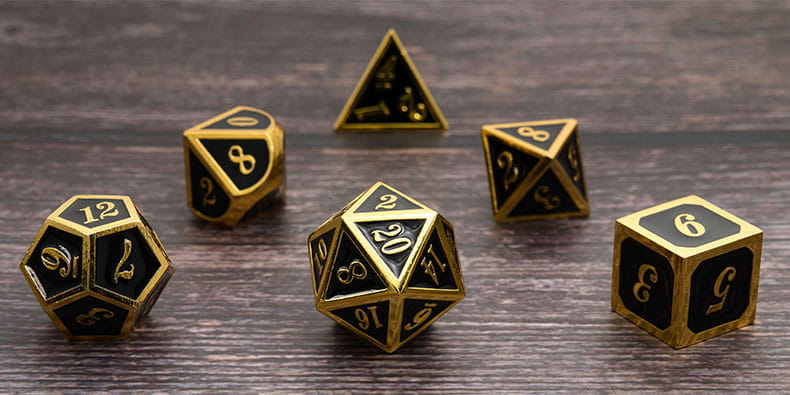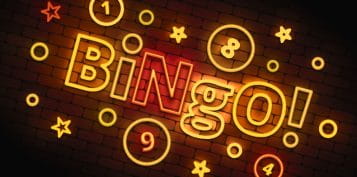The History of Dice – History’s Oldest Gambling Tool
Since the age of pharaohs, dice have been an essential tool for determining someone’s fate, whether that is through divination or a gambling game. Read on to learn everything about the fascinating history of dice and discover the most ancient dice games. Use the buttons below to navigate through our blog:
Dice History – What are Dice?
Before jumping into dice history, it is good to know what dice are. These are small objects of varying shapes and sizes with symbols, dots or numbers displayed on each side. All sides have a set value, and players throw either one or more to get a random result. The meaning of each value depends on the type of dice gambling game you’re playing.

While it was initially believed that dice originated in Ancient Greece, later excavations discovered six-sided dice in Egyptian tombs from as early as 2000 B.C. Dice were mentioned in the Mahabharata, an ancient Sanskrit epic, and they were also used in a Sumerian board game. Although the exact origin of dice is unclear, it is evident that dice have been an integral part of gambling since the dawn of time.
Ancient dice only had two decorated sides and were usually made of sticks or shells. Later, people would start using astragali (knucklebones) as four-sided dice, which were the ankle bones of large hooved animals. Eventually, six-sided dice were created using bones, bronze, precious stones and more. Some excavations even found 20-sided dice in Egyptian tombs. But how were these dice used?
Ancient Dice and Games – Will of the Gods
Before being used in ancient gambling games, dice (particularly knucklebones) were used in divination. Various cultures would throw dice and attempt to decipher the gods’ will through the results, with each side having a name: belly, hole, ear and vulture. Ancient dice were so coveted that many people were buried with their favourite sets.
The exact start of the history of dice games is also unclear, although evidence suggests board games have existed since the third millennium B.C. The Sumerian Royal Game of Ur was a board game where players tossed four-sided dice and moved their pieces to reach the goal before their opponent. Its rules were preserved on a tablet and discovered by Irving Finkel. The game has been revived and is still played today.
Egypt also had a board game called Senet, and dice were present in both ancient Greek and ancient Roman gambling. Although it was illegal in ancient Rome, many Romans still practised gambling and even had a term for gambling, “Aleam ludere”. Dice came in two types: tali were large four-sided dice with numbers one, three, four and six, while tesserae were small six-sided ones with numbers one through six.
Generally, the smaller dice were used for high-stakes ancient dice games and dice towers (cups with dice inside) were used to toss them. Meanwhile, the ancient Chinese used based cards and dominoes on dice, with dominoes representing all possible dice combinations. Ever since the origin of dice, they have been popular worldwide.
Modern Dice Games – Dicing Across the World
The history of dice continued throughout humanity’s medieval and modern ages as people worldwide began creating fun new games and variations of existing ones. Sic bo is a game still played in modern casinos, where players bet on a specific outcome, and the dealer shakes a chest with three dice to determine the result. Below, we have listed some other popular dice gambling games:
- 🎲 Backgammon
- 🎲 Chō-Han
- 🎲 Kitsune Bakuchi
- 🎲 Cee Lo
- 🎲 Craps
- 🎲 Hazard
- 🎲 Crown and Anchor
- 🎲 Mexico
- 🎲 Poker dice
- 🎲 Tien Gow
The dice history can sometimes be just as fascinating as the games themselves. For example, Hazard is believed to have been played during the Crusades. Meanwhile, craps is a simplified version of Hazard, created and brought to the U.S. by Bernard de Marigny in 1805. Although the upper class rejected it, lower classes enjoyed the strategic gameplay that rivalled the top roulette strategies.
Craps would become incredibly popular during WWII and became a staple at Las Vegas casinos upon the soldiers’ return. Other popular games include Crown and Anchor, where you bet on specific symbols and Cee Lo, which can be played against other players or a dealer. There are many other fun games, such as Balut, with dice with poker symbols, or the Chinese game Tien Gow.
Naturally, many board games and other fun casual games were also invented. Diceball, which would eventually get a casino version, is a simple version of craps with a baseball theme, while Yahtzee is a popular scoring game with dice. Meanwhile, the popular Dungeons & Dragons franchise is a tabletop RPG that uses all types of dice.
Dice Manufacturing and Why it is Important
While it was initially believed that ancient dice were guided by supernatural forces, starting in the 17th century, mathematicians began exploring the concept of randomness and probability. That was significant for the history of dice games, especially for casinos, as the construction of dice substantially impacted randomness. The significance of dice construction is just as crucial as pari-mutuel betting is to the history of sports gambling.
As such, manufacturers began producing special precision dice for casinos, which were as close to perfect cubes as possible. Aside from all dimensions being accurate to within 0.00001 inches, the dice have sharp corners that get caught on the felt and ensure rolls are random. Even the dots are drilled in and filled with paint with the same density as the overall material. That ensures that the centre of gravity is not displaced.
Unlike those in ancient dice games, casino dice are made of cellulose acetate. That makes the dice transparent, which further helps prevent cheating. Additionally, all casino dice have serial numbers and are swapped out regularly. Once a die can no longer be used, it is pressed with a vice or marked and removed. While they are typically red, casino dice can come in various other colours, such as green and blue.
Meanwhile, regular dice are made through machines’ moulds and typically have rounded edges. This makes them less precise, but the numerous shapes and sizes are the trade-offs. Some players even have fun simply collecting dice and enjoying the various colours and shapes, whether it’s the classic six-sided die, 20- and 100-sided dice used in tabletop RPGs or strange Mobius strip dice.
Cheating in Dice Games
As with all gambling games, the history of dice is no stranger to cheating. Players and dealers would attempt to manipulate results through loaded dice or unique throwing methods to win more often. Below, we have listed some of the possible ways to cheat with dice, so you can spot and avoid them more easily:
| 🃏 Method | 📖 Explanation |
|---|---|
| Loaded Dice (Passers, Bricks) | Parts of the dice are shaved down, or extra weight is added, which makes specific numbers appear more frequently. |
| Duplicated Dice | One or more faces have exact copies on their opposite side, so specific results are more frequent. Not to be confused with six-sided d2 and d3 dice. |
| Controlled Shots | Sliding or throwing the dice in a way that produces specific outcomes. It takes skill and talent but is still considered cheating. |
Even during the early days of dice history, cheaters could still get caught, and various methods to avoid it were introduced. That included putting dice into cups and rolling them inside so players couldn’t swap them. These days, land-based casinos typically have cameras and spiky bumpers on the tables to prevent cheating. You may also be required to shake the dice before throwing.
With the advent of online gaming, many casino sites have excellent security measures to ensure players can’t hack or cheat on their games. Meanwhile, you can be confident that no licensed casino will rig the titles in their favour. While you may not pull off tricks such as the ones in the best gambling movies, you can enjoy the same excitement that many players felt throughout the history of dice games.
The Future of Dice Games
From ancient dice to modern 100-sided dice, these colourful objects have an impressively long history. Whether it’s through casino titles, board games or unique war games, dice are popular among gamblers and the public. Dice games are also incredibly varied, with various fun gimmicks and rulesets to satisfy all player types. As online and live casino dice games become more popular, we are excited to see what other fun titles the future holds.
We hope you enjoyed our look into the history of ancient dice games. Those interested in ancient cultures and their gambling customs can check out our article on the gods of gambling. You can also find a detailed look at the history of Las Vegas and learn how this critical gambling destination was established.
History of Dice FAQ
Before wrapping up our history of dice blog, we will answer all your pressing questions. Learn some extra details on the history of dice, such as which were the most famous ancient dice games. Additionally, you can learn more information about the production of dice and how casinos prevent cheating.
Similar Articles


